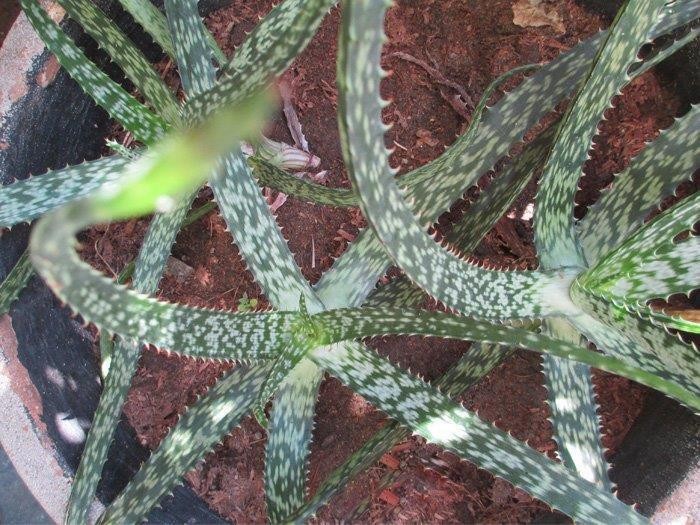By Tommy Clarkson from the February 2015 Edition
Pachypodium lamerei
Family: Apocynaceae
Also known as: Devil’s Backscratcher
The genus of Pachypodium are shrubby succulents, most of which have thick, prickly stems, strap-like leaves and five-petaled, funnel-shaped flowers terminal clusters.
The unique Madagascar Palm combines features of both palms and cactus and your guess as to its origin is correct – in the southern part of that unique island. It is the biggest species in the family and, interestingly, attractive kin of Plumerias.
It is a long liver (as opposed, I suppose, to a short spleen) and to say that it likes warm environs and sun is to state the obvious. It sports thick, thorny stems with a cluster tuft of narrow leaves near its top. The flowers are fragrant, white with yellow-throats and are about four inches (10 cm) across.
Drought-tolerant, it is a good choice for xeriscaping but, of course, plant in well-draining soil. However, I have heard of one gardener in South Texas, who heavily watered his Madagascar Palms every other day and gave them fertilizer (probably something like a 10-60-10) weekly, resulting in plants that were so fast growing that he had to regularly take top cutting to keep them from growing too large! That having been said, I have read of other gardeners who have very healthy specimens of 16-17 feet (4.9 to 5.2 meters) tall. The norm for a mature specimen, however, would be one of, perhaps, ten to twelve feet (3 to 3.3 meters).

The silvery gray to tan trunk is generally swollen at the base and looking like in inverted carrot tapers with height. Very sharp, one inch (2 ½ cm) long gray to black spines are grouped in threes. As earlier mentioned, atop the plant are generally no more than two to three dozen, linear-elliptic, slightly arching leaves. These are from ten to eighteen inches (25 ½ to 46 cm) long and are a deep green color with a slightly lighter colored, prominent, mid ridge. The flowers grow from the middle of this leaf crown.
The easiest way to propagate these is from stem cuttings. However, make sure that the cut surface is calloused over before planting. Starting from seeds is a wholly different proposition. To most effectively do so, bag the plant’s seed heads to capture the ripening seeds. Allow these twin horned pods to dry on the plant after which you may break them open to collect the seeds.
You might consider soaking these seeds in warm water for 24 hours prior to planting. Pachypodium lamerei seeds do not store well, so I encourage you to sow them as soon as you are able. One last propagation option is in the small branch-like offshoots that sometimes appear at the base of the plant. These can be removed to produce new plants.
Branching occurs naturally in Madagascar palms that have suffered an injury, though mature plants occasionally branch without being damaged. Such happens primarily in older specimens and will come about after blooming. Ones planted outdoors are more likely to flower and branch than those grown indoors.
You may be able to induce branching by cutting the top of the plant. However, this process requires injuring the center of the spiral from which the leaves normally grow. So, if you choose this method, use a sterile knife to reduce the risk of infection. Most Madagascar palms recover from this operation but there’s always a possibility the “patient” won’t survive the ordeal.
(Caution: In that its spines are extremely sharp and in ample abundance on its trunk, these plants should be planted away from foot traffic.)
Though not common, if your Madagascar Palm shows signs of disease or pest infestation, remove the damaged parts.
These are moderate growers, though they often take off quickly once ensconced in your garden. In a container the growth rate will be slower. If your Madagascar Palm’s home is a pot you will need to move up in size every three years or so. This is bit of a challenge as a result of those needle-like spines. Perhaps the best procedure is to wrap several layers of newspaper around the trunk where it is to be handled.
A few confuse the Madagascar Palm with the Half-Man or Ghost Palm, (P. namaquanum) or the Elephant’s Foot Plant, (P. rosulatum). But this latter one should not be further confused with the Elephant’s Foot or Ponytail Palm, Beaucarnea recurvata – which is not a palm but a succulent. (Yes, it all sometimes becomes most befuddling!)


For back issues of “Roots”, gardening tips, tropical plant book reviews and videos of numerous, highly unique eco/ adventure/ nature tours, as well as memorable “Ultimate Experiences” such a Tropical Garden Brunches. Visit us at.. www.olabrisagardens.com
Download the full edition or view it online
—
Tommy Clarkson is a bit of a renaissance man. He’s lived and worked in locales as disparate as the 1.2 square mile island of Kwajalein to war-torn Iraq, from aboard he and Patty’s boat berthed out of Sea Bright, NJ to Thailand, Germany, Hawaii and Viet Nam; He’s taught classes and courses on creative writing and mass communications from the elementary grades to graduate level; He’s spoken to a wide array of meetings, conferences and assemblages on topics as varied as Buddhism, strategic marketing and tropical plants; In the latter category he and Patty’s recently book, “The Civilized Jungle” – written for the lay gardener – has been heralded as “the best tropical plant book in the last ten years”; And, according to Trip Advisor, their spectacular tropical creation – Ola Brisa Gardens – is the “Number One Tour destination in Manzanillo”.





You must be logged in to post a comment.